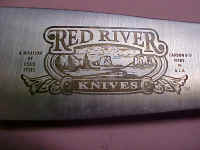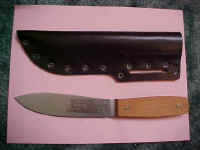Old Hickory II: The "Trade Knives" of Cold Steel
by A.K. Church, who is pretty cold himself
with gracious photography assistance from Doc Tom
(Free permission to quote Church's articles is granted, as long as proper attribution is given. We request that if you use our work, you give us credit.)
The knives I will discuss here are slightly mysterious, not because they were produced long in the past, but because they were a commercially unsuccessful venture from a company big enough to move on without looking back after a product line fails to make money.
These were readily available in the early to mid 1990s, and were essentially copies of Russell-Harrington patterns long established in their "Green River" lineup. The Cold Steel knives were, in my opinion, significant improvements over the Green River products in 2 respects:
(1) Cold Steel's proprietary Carbon-V is a really good mass production blade stock-I think better than whatever Russell uses. Cold Steel has tried to build up the image of Carbon-V as a dragon killer steel of mystery, which is a bit excessive, but it's one of the better mass production high carbon steels. Edge holding is excellent, and the thin wedge grind bevel is easy to maintain.
(2) The sheaths on these externally copy the original 19th century Prairie style of belt-over sheath. Leather quality is variable and at least one of my knives has really soft thin weak leather. This is much less of a problem with the Cold Steels because of a plastic hard liner hidden inside the sheath, which does much both for retention and protection. Again, this is superior to the off-the-shelf sheaths of the Russells.
Shown with sheath
Apparently four styles were produced, all using the same sheaths interchangeably. All are arguably derivative of Russell styles though the Russell patterns in many instances go back prior to the 19th century. I make no claim of being a knife historian, the point is that all 4 styles are old, tested patterns.
The first, and apparently most common, pattern is a clip point hunter. Blade length is 6 inches, length overall is approximately 10.25 inches. Construction is very simple with 2 hardwood slabs riveted with 2 brass rivets to an untapered tang. Most sources refer to the handle wood as hickory, and that is indeed what it looks like. This style also happens to be my favorite.
The second most common pattern is the butcher. Mildly curved, it carries a fairly blunt upswept tip. Blade length is 7 inches, l.o.a. is 11.25". Handle details follow the clip point. This is the other easy-to-find style.
A third pattern, quite uncommon in the author's experience, is a curved blade skinner. I do not have one to examine, but recall it as being of the same approximate size as the butcher. Obviously I may be wrong on this.
Finally, a fourth style carried a finer-pointed blade greatly resembling a French Chef's knife. I have only seen 2 of these. I believe these were of the 6"/10.25" configuration, but again this is from memory.
These knives were widely available at gun shows up 'til about a year ago at prices running $8-$15. Now they are starting to become scarce. I do not suspect these will ever be collectable. As utility knives they are hard to beat for the money.
They do have their failings. The steel is carbon and it will tarnish readily. This doesn't bother me particularly, but I note jalapeno jack cheese will do the job in hours instead of days. The handle slabs on these are usually sharp cornered. User comfort will benefit greatly by eliminating these "hot spots". This can be easily done with a knife, file, sandpaper or , as I do it, with a wood burner.
These are also starting dry up. I've already mentioned this. But given the range of pricing, they are an item I specifically look for at gun shows and on electronic auction sites. I have acquired by quick count, 9 of 'em. 6 clip points, 3 butchers.
They are worth seeking out.
Anyone possessing catalogues featuring these knives is invited to email author Church. For sentimental reasons the author also is looking for clip point hollow handle "survival" knives of the Lifeknife brand.
Email me your experiences with these knives so I can post it here.
The author adds links to another gentleman's write-up of the Red River knife; please click here ...
...and for a good write-up of the Cold Steel Hudson Bay knife, click here.
NOTE: Author Church regrets that he is unqualified to do appraisal, and cannot establish a value on your gun.
visitors since website crashed
AUG 2003
Mr. Church
I have at least 2 of each of the Red River models. The one you likened to a French chefs knife has a 7" blade. The skinner was named the Elk Skinner and has a 6" blade. We use them in the kitchen and the field. My wife is hard on knives and managed to knock a half-moon chip out of the edge of one of the butcher knives, trying to chop something or other. The steel, on this example at least, is brittle. The only one I find to be suitable for field use is the skinner. I use it on deer and elk and it works great. The blade maintains its thickness almost to the tip for strength. The others all taper more. It also has enough curve to skin well but not so much that you can't whittle with it.
The handles on all of them got loose, probably from this dry climate. A rap on the rivets with a hammer fixes it.
The sheathes come in 2 sizes but due to the design it doesn't really matter if you use the wrong one. They do not work well on the belt because the belt slot is too near the top of the sheath so that not enough of the handle sticks up above the belt.
If you have any other questions feel free to ask.
Leo Touzjian
Allenspark CO


